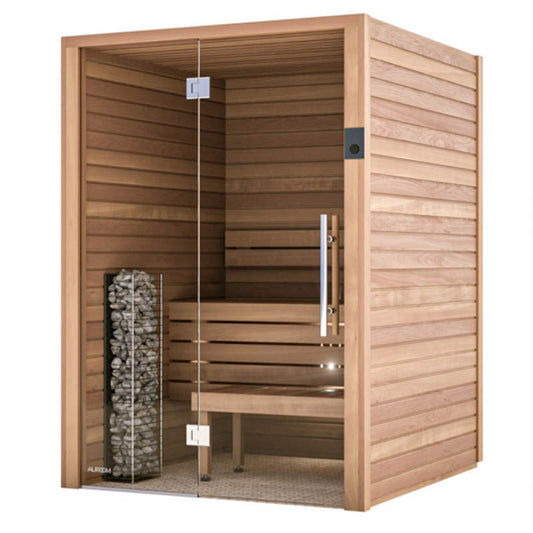The Only Guide for Traditional Sauna
The Only Guide for Traditional Sauna
Blog Article
Indicators on Traditional Sauna You Need To Know
Table of ContentsSome Ideas on Traditional Sauna You Need To KnowTraditional Sauna - An OverviewThe 10-Minute Rule for Traditional SaunaTraditional Sauna - Truths
Most of the weight lost in a sauna is water loss and is re-gained upon rehydrating. Without a question sauna can be an essential part of a healthy and balanced weight loss program. To check out the differences in between traditional and IR saunas, I will separate these right into verifiable, academic, and made distinctions.Thus, the best factor in the saunawhich goes to the ceiling straight over the sauna heateris generally between 185 and 190 F. Traditional Sauna. Claims that a standard sauna goes beyond 200 F is simply not real and not applicable for electric saunas marketed in the US. The temperature for a far-infrared sauna is usually established between 120 and 140 F; nevertheless, unlike the standard sauna, the goal in and IR area is not to accomplish a heat
As a result of this, the temperature level difference is practically unimportant, since extreme sweating leads to both sauna types, however the technique of heating up the body is different. In an IR sauna the bather will certainly really feel warm and will sweat profusely, but at a lot reduced temperatures. Hence, if the goal is to invest longer amount of times in the sauna, the IR sauna is a good selection.

Traditional Sauna Fundamentals Explained
When the high temperature is accomplished, the aspects cycle on and off to keep the heat. Most traditional sauna users appreciate putting water over the rocks to create steam to elevate sauna humidity degrees. The advantages of putting water over the rocks consist of: making the area more comfy, dampening the nasal flows, and permitting the use of aromatherapy by blending vital oils with the water.
In a far-infrared sauna, the warm waves pass through the body to effectively heat the body and raise the body core temperature. To accomplish this enhanced temperature, Far-infrared emitters develop infrared power which is close to the very same wavelength as that which the body normally emitsoften referred to as the "Vital Variety" of 7 to 14 microns), so the power is well received by the body.
When the energy goes into the body, it causes the body temperature level to increase and ultimately results in sweating. In an infrared sauna it is essential for the emitters/heaters to continue to be on almost constantly. Given that there is no mass of rocks to keep warmth, the sauna will cool down if the emitters shut down.
As mentioned above, the sauna bather in an infrared room wishes to place himself in front of operating emitters to obtain optimal benefit from the heat. The home heating time for the 2 spaces can be extremely different, depending on just how the spaces are used. For a traditional sauna, a bather needs to enable 30-40 minutes for the area to accomplish a desired temperature level and to correctly pre-heat the rocks.
3 Simple Techniques For Traditional Sauna
A well built sauna will generally attain a temperature level of 150-160 F in about 30-40 minutes. For hotter temperature levels, the space might need to warm for a longer duration.
To some, 15 minutes was "lost" while the infrared energy heated up the timber panels instead of heating up a body, while others locate a pre-heated area to be much more comfy and think a raised beginning temperature is necessary to begin sweating. The size of look at here advised use for every area is roughly the exact same (10-15 minutes per session); nevertheless, because of the reduced air temperature levels and the capability to really feel the impacts of infrared warm quicker than a typical sauna, it is not unusual for an individual to invest an overall of 20-30 minutes in an infrared sauna.
Standard saunas often tend to be bigger (therefore use even more electrical energy) than infrared saunas, although traditional saunas are definitely readily available in one and two person sizes as well. For a two-person typical sauna, 5x6 or 5x7 dimension is most prominent. The top bench can easily seat two or 3 individuals and is also long enough to rest throughout the sauna session.


The average cost per kWH of power in the U.S. is about $0.11, so a 4.5 kW heater will cost about $.50 to compete one hour, if the heating unit runs continuously for one hour. Normally a sauna heating unit will certainly run for 75% of the first hour and 50% of subsequent hours on considering that the components cycle once the set temperature is achieved.
Traditional Sauna for Beginners
A two person far-infrared room is normally literally smaller than a conventional sauna, commonly regarding 4' x 4' or smaller. The IR heating system is usually 1.5-1.7 kW utilizing a 120 volt 15 amp plug-in solution. Because the area can be used quicker than a sauna area, we will presume the area is utilized for to of an hour consisting of warm up time.
There is a hardly ever talked about difference in the social experience in between the two areas. While our culture has actually shed several of go to my blog the social benefit of the traditional sauna experience, it can be really socially satisfying. From household time in the sauna, to heart-felt conversations with considerable others, to sauna partiesthe conventional sauna experience can result in intimate socializing.
The majority of higher end infrared areas consist of colored light therapy, sound Get More Information systems and full-glass fronts.
Report this page